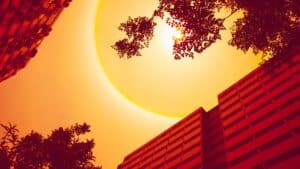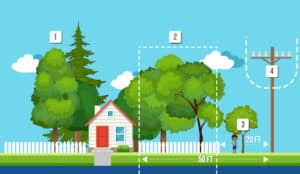
Mitigating Heat Island Effects with Trees
Mitigating Heat Island Effects with Trees: A Guide for Landscape Designers, Architects, and Urban Planners
Trees play a crucial role in mitigating heat island effects, which refer to urban areas becoming significantly warmer than surrounding rural areas. “About 85% of the U.S. population lives in metropolitan areas,” according to Climate Central. “Neighborhoods in a highly-developed city can experience peak temperatures that are 15°F to 20°F hotter than nearby areas with more trees and less pavement.”
Here’s how trees help cool things down:

Evapotranspiration: Trees act like living air conditioners through a process called evapotranspiration, which is a combination of evaporation and transpiration. Leaves absorb water from the soil and release it into the atmosphere as vapor. This process uses energy, which cools the surrounding air. A single mature tree can transpire hundreds of gallons of water per day, resulting in a notable temperature decrease.
Humidification: During evapotranspiration, trees also release moisture into the air, increasing humidity. This can have a cooling effect on skin, making it feel cooler than the actual air temperature. Increased humidity can also reduce water evaporation from bodies of water and soil, further contributing to overall cooling.
Reduced Building Energy Consumption: Shade provided by trees reduces the need for air conditioning in buildings, lowering energy consumption and greenhouse gas emissions. This creates a positive feedback loop, as lower energy use helps combat climate change, which in turn helps mitigate heat island effects. “Not only do trees provide privacy, beauty and homes for many animals, planting the right tree in the right place can also save you money on your electric bill,” according to the Jacksonville Electric Authority. “It is very important to research different types of trees and plant them in a location that will benefit your home.”
Wind Patterns: Trees act as windbreaks, disrupting strong winds and creating pockets of calmer air. This can help circulate cooler air from surrounding areas and prevent hot air from stagnating in urban canyons.
Heat Island Crusaders: “Landscape architects play a lead role in greening our cities and communities in order to make them cooler,” according to the American Society of Landscape Architects. “They work with architects and engineers to design green roofs, walls, and streets, and other green infrastructure as zones to inhabit during extreme heat events and hotter-than-average summers. Landscape architects can identify the tree and plant species best suited to generate a cooling effect while minimizing harmful volatile organic compounds (VOCs).”
Overall Benefits: Mitigating heat island effects improves public health by reducing heat-related illnesses, increases comfort and livability in urban areas, and encourages outdoor activities. It also benefits the environment by reducing energy consumption and pollution.
Here are some additional facts to consider:
- The more trees in an area, the greater the cooling effect.
- Different tree species have varying levels of effectiveness in mitigating heat island effects. Choose the right tree for the right place.
- Planting trees along sidewalks and building walls is particularly effective in providing shade and cooling.
By understanding the principles involved in mitigating heat island effects with trees, we can create cooler, healthier, and more sustainable urban and suburban environments for everyone.
From our office in Atlantic Beach and satellites throughout Northeast Florida, Rockaway Inc., your outdoor living experts, proudly serves both commercial, HOA’s, and residential landscape design, maintenance, lawn care, irrigation, and outdoor living carpentry in Jacksonville, St Augustine, Atlantic Beach, Neptune Beach, Jacksonville Beach, Ponte Vedra, Nocatee, St. Johns, and Fernandina Beach.
